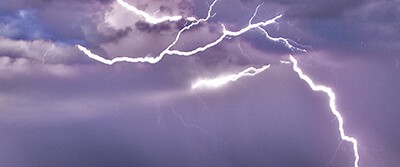Warmer, Wetter Climate to Impact Thunderstorm Intensity

By Kylie Wolfe
Researchers recently shared new findings that predict the impact of a warmer climate across the continental United States in the coming years. Simulations revealed that a continued rise in both temperature and precipitation may cause thunderstorms to increase in intensity.
Forecast the Future
A study at Colorado State University produced detailed simulations of future weather patterns using the Weather Research and Forecasting model developed by the National Center for Atmospheric Research (NCAR) in Boulder, Colorado. The model was run at a higher resolution than that of prior studies to provide more detailed information about cloud processes and topographical features. Running the simulations with the natural environment in mind allowed for more accurate results across the entire country.
The first simulation was reflective of actual weather patterns from 2000-2013, including storm movements and correct daily precipitation cycles. The second simulation mirrored global warming conditions, assuming a two- to three-degree average temperature increase and double the amount of atmospheric carbon dioxide.
A Perfect Storm of Interesting Findings
The researchers’ forecasts showed that weak-to-moderate thunderstorms will decrease in frequency as intense storm systems become more common. The resulting increases in rainfall, lightning and strong winds are expected to contribute to more flash floods, fires and tornados.
Scientists attribute these projected weather patterns to changing thermodynamic conditions. Warmer, wetter weather increases the amount of energy in the atmosphere; consistently warmer temperatures will maintain that high level of energy and release it in the form of severe thunderstorms. Maintaining this energy balance is ultimately what drives different weather patterns.
Moving forward, scientists want to continue to assess the physical processes of clouds using high-resolution techniques to better gauge the consequences of climate change. Meanwhile, researchers plan to conduct further simulations to gain more insight on general weather and storm patterns.
Discussion Questions
- Define climate and weather and explore how they differ and how they are related. Write a sentence using each word to describe what’s happening outside your classroom.
- How do changes in temperature impact the weather/climate we experience and the thermodynamics of those systems? Discuss the Laws of Thermodynamics and apply them to variations in weather/climate.
- How do topography and geography influence weather/climate? Take time to research and discuss mountain ranges, bodies of water, wind patterns and elevation.
Vocabulary
- Climate
- Weather
- Convective System
- Topographical Feature
- Thermodynamics